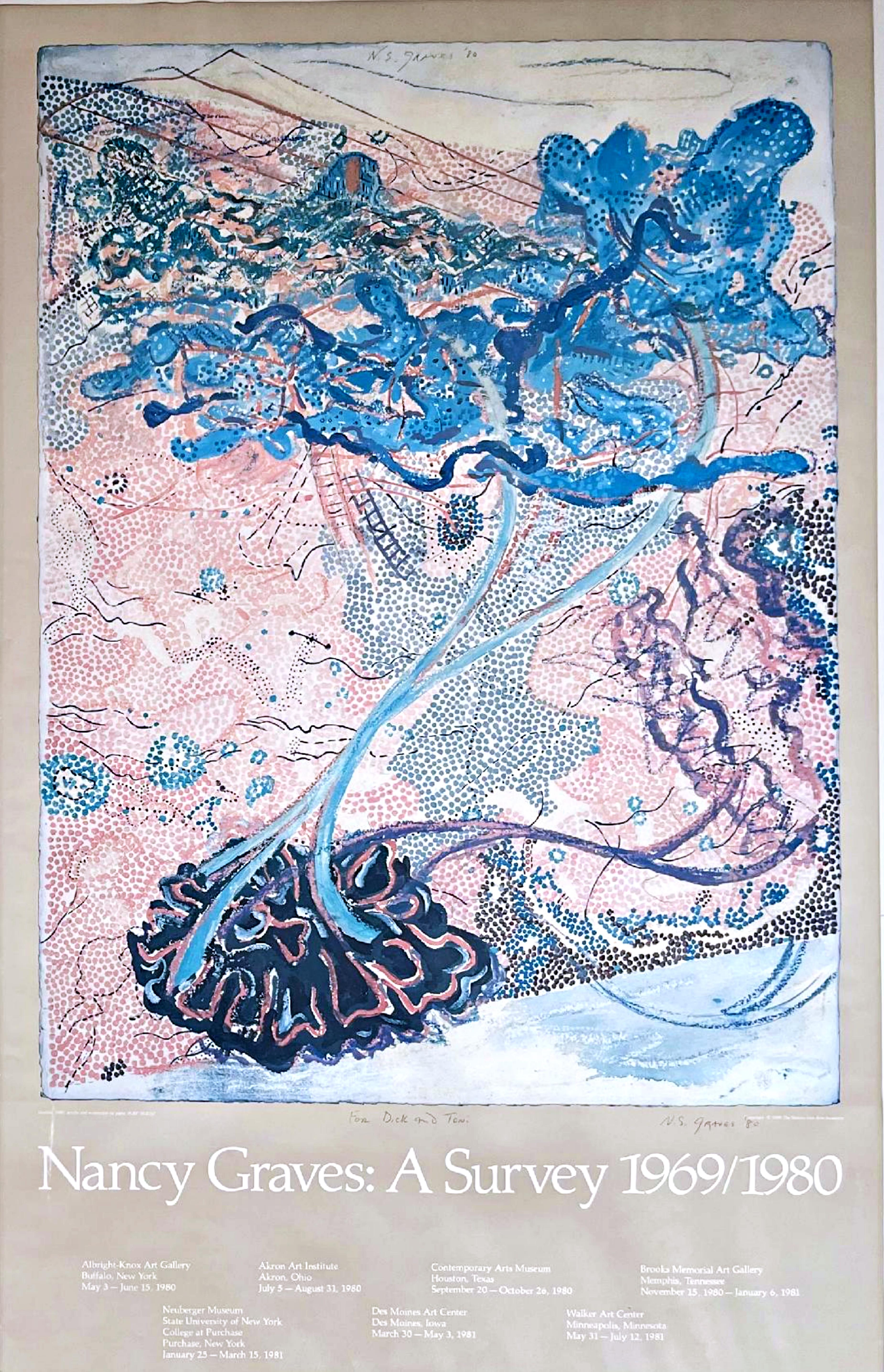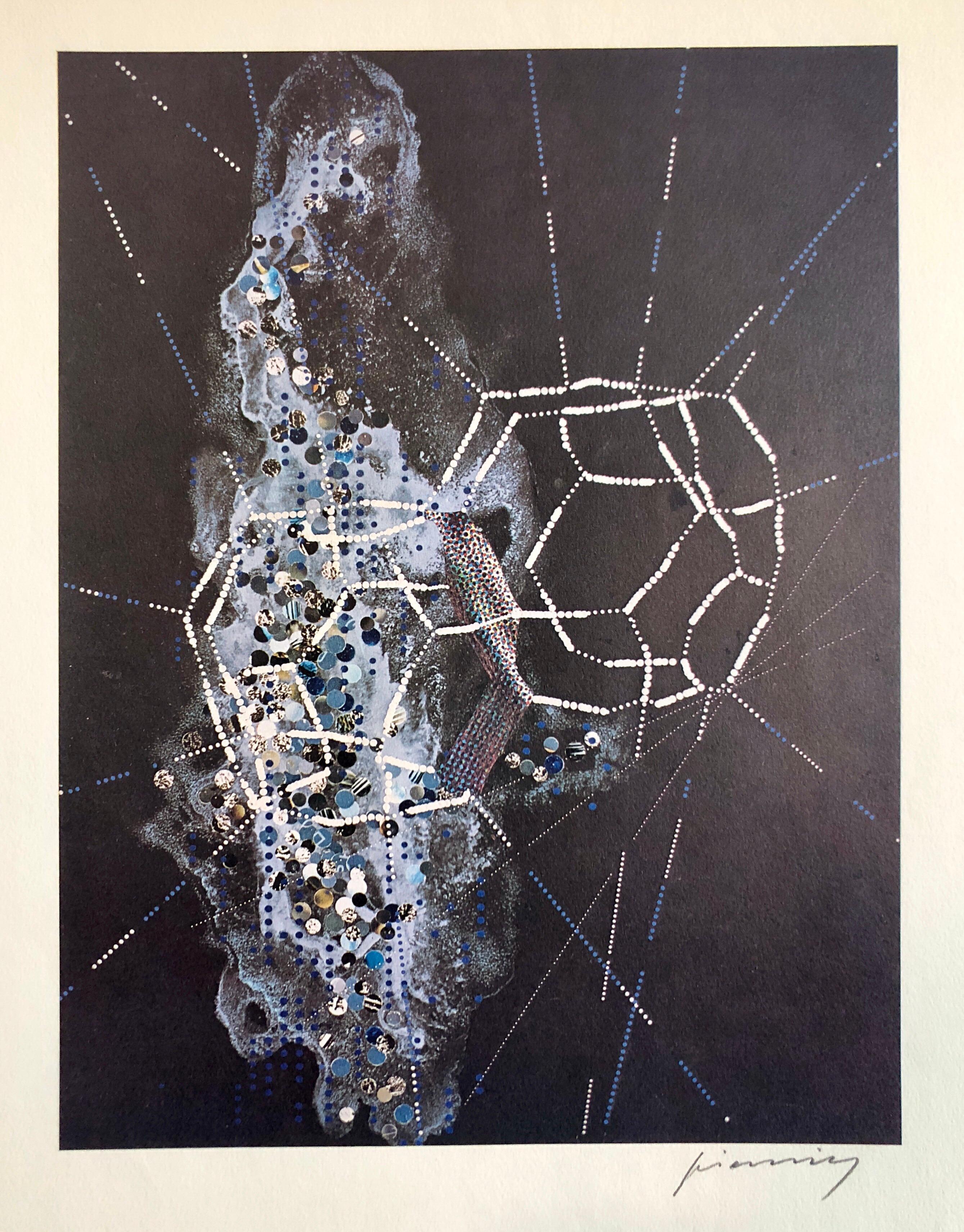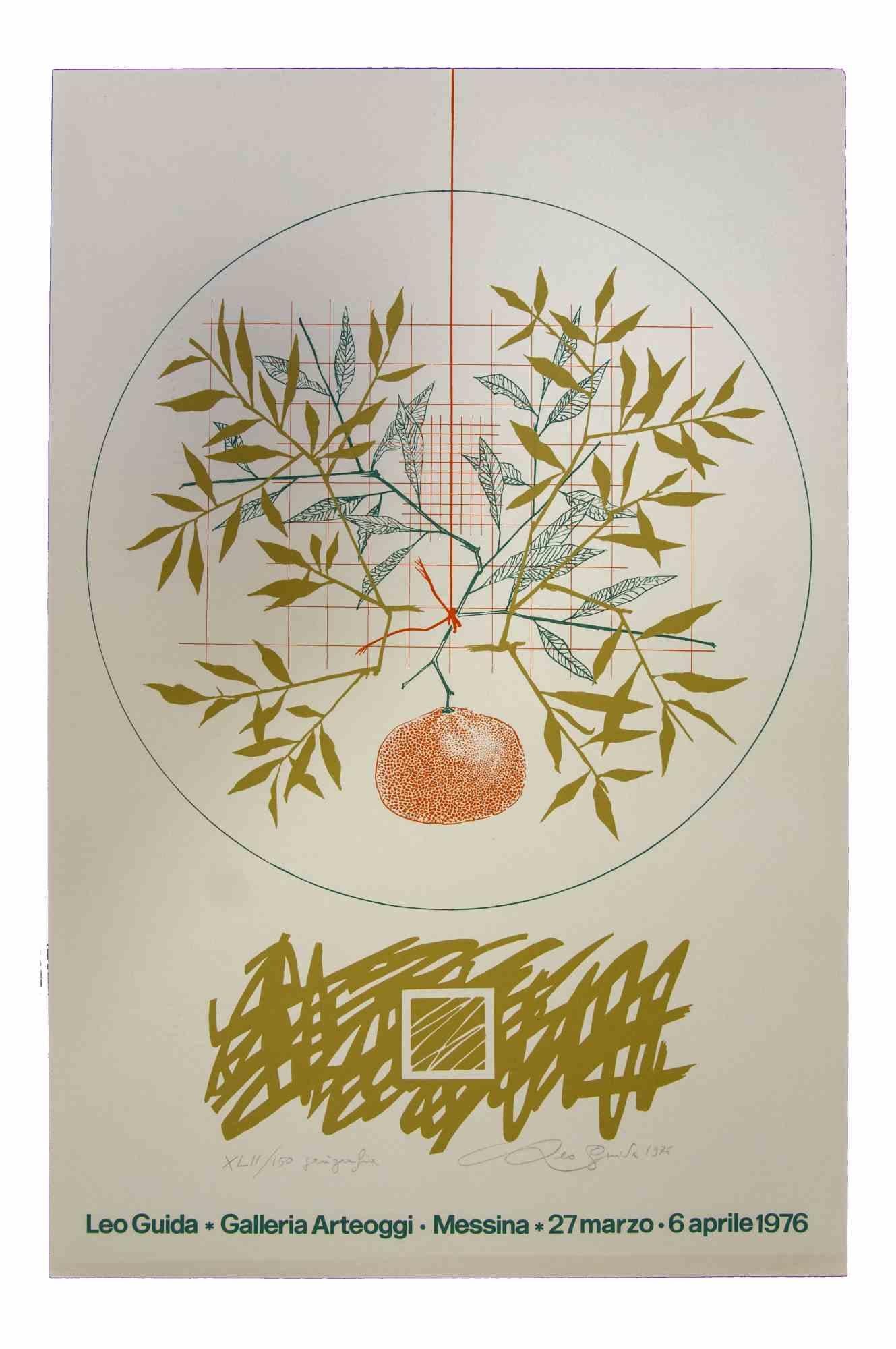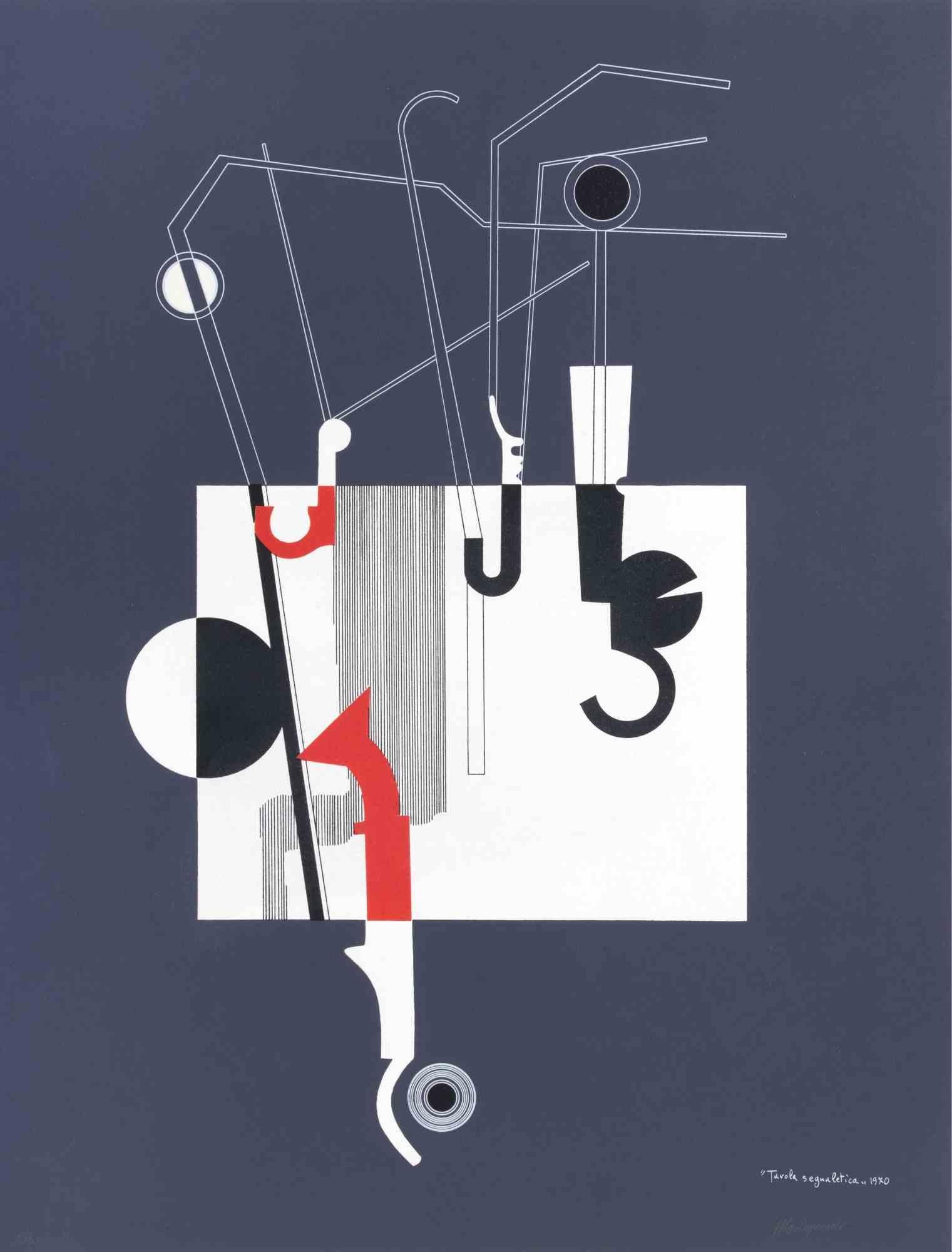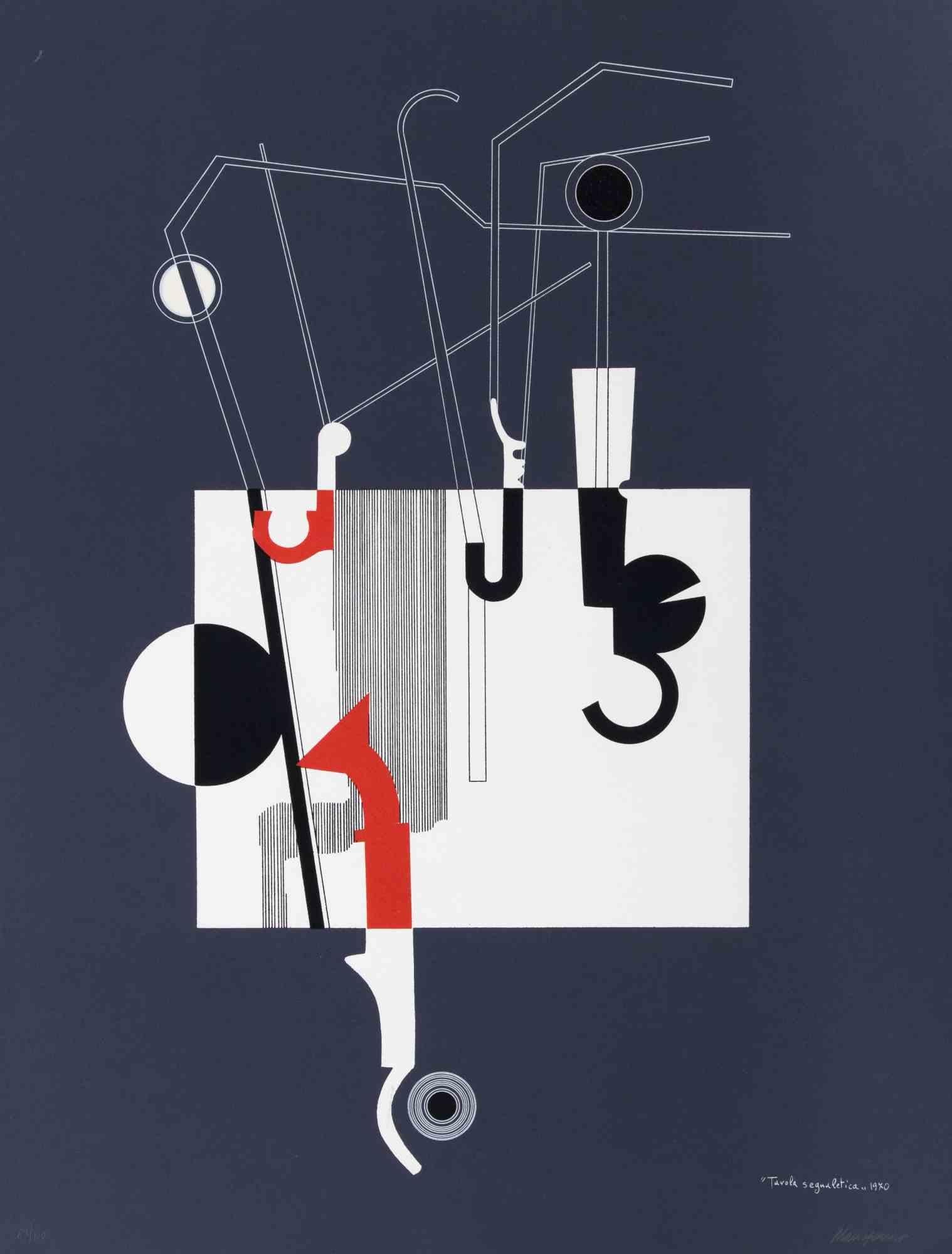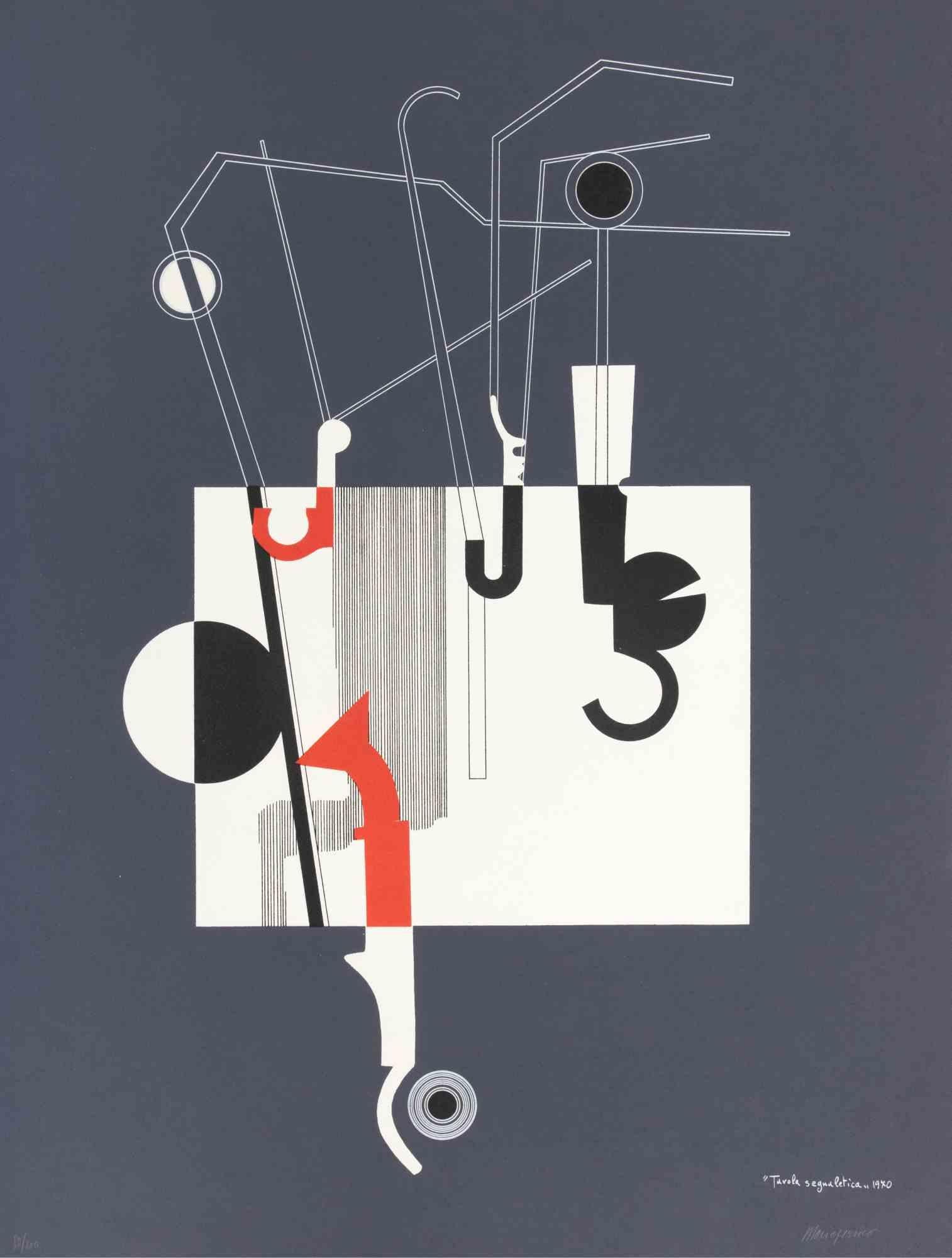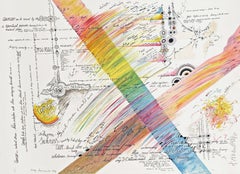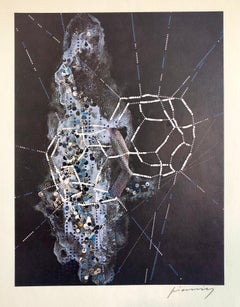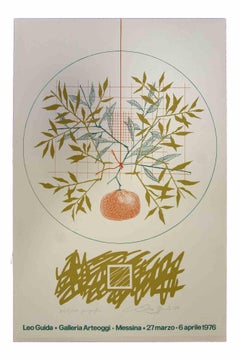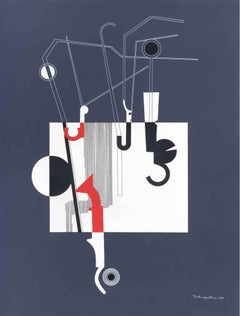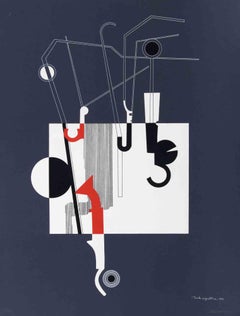Items Similar to Rare historic 1960s Lt Ed Fluxus poster Pittsburgh International Carnegie Museum
Want more images or videos?
Request additional images or videos from the seller
1 of 11
Mary BauermeisterRare historic 1960s Lt Ed Fluxus poster Pittsburgh International Carnegie Museum1967
1967
$1,000
£752.21
€867.05
CA$1,408.61
A$1,545.58
CHF 808.89
MX$19,020.87
NOK 10,190.74
SEK 9,545.15
DKK 6,474.15
About the Item
Mary Bauermeister
Pittsburgh International Carnegie Museum, 1967
Offset Lithograph Poster
20 × 37 inches
Edition of 500
Unframed
This is the original, historic poster designed by Mary Bauermeister for the 1967 Carnegie International Exhibition of Painting and Sculpture in Pittsburgh. A collectors item for fans and followers of Bauermeister!
A multidisciplinary artist known for her intricate, enigmatic assemblages, Mary Bauermeister (1934–2023) often defies categorization. A precursory figure of the Fluxus movement—her studio was the meeting point for a number of movement-defining Happenings—her work plays an integral role in the evolution of both the European and American avant-gardes of the 1960s. Her reliefs and sculptures, which incorporate drawing, text, found objects, organic materials, fabric, and more reference myriad concepts: natural phenomena, astrology and other cosmologies, astronomy, art history, mathematics, the nature of language, and her own “spiritual-metaphysical experiences” were all engaged as conceptual underpinnings in Bauermeister’s multifarious works. Maturing amidst the currents of Minimalism and Pop Art, Bauermeister’s art has resisted labels due to the singular expression of her interests and concerns. Overarching tropes in her oeuvre ponder the simultaneous transience and permanence of the natural world, the optical effects of transparency and magnification, and key dichotomies such as multiplication and variation, structure and order, chance and ephemerality, introversion and extroversion. Her three-dimensional works act as receptacles for her thoughts, ideas, and notes as she investigates a variety of visual and philosophical paradoxes related to the nature of perception, offering a literal and metaphorical window into the inner workings of the artist’s mind.
Born in Frankfurt am Main, Germany, Bauermeister’s childhood was defined by totalitarianism and war. This environment of tremendous destruction and suffering naturally shaped her as a person and, later, as an artist. Finding respite in her studies of nature, science, and mathematics, Bauermeister attended secondary school in Cologne from 1946 to 1954. There, her artistic talent emerged under the direction of her drawing teacher, Günther Ott, who encouraged her to pursue an art practice. In 1954, she enrolled at the Hochschule für Gestaltung (the Ulm School of Design) where she took courses with the Swiss artist, architect, and designer Max Bill and the textile artist Helene Nonné-Schmidt, who had studied under Paul Klee. Unable to align herself with the school’s rigid Constructivist mandates, Bauermeister decided to leave after a semester, explaining in a letter to Ott: “The only artworks which receive serious attention here are constructed, mathematically provable, rectangular…”[i] She then enrolled at the Staatliche Schule für Kunst und Handwerk (State School of Arts and Crafts) in Saarbrücken, studying with photographer Otto Steinert. In late 1956, Bauermeister returned to Cologne, where she supported herself by selling her pastel works on paper while cultivating a career as an artist. Between 1960 and 1961, she rented a studio on the top floor of Lintgasse 28, a space that not only fostered her mature art practice, but also became the venue for numerous vanguard exhibitions, concerts, and performances among Bauermeister’s wide circle of friends. John Cage, Merce Cunningham, Nam June Paik, Christo, Karlheinz Stockhausen, and many other visual artists, musicians, poets, and dancers convened at the studio to participate in what became the earliest Happenings, earning Bauermeister the title “mother of the Fluxus movement.” She continued to nurture a close friendship with Stockhausen, an influential composer of electronic and serial music, with whom she also collaborated in a creative capacity; the couple married in 1967 and had two children, Julika and Simon, before divorcing in 1973. Bauermeister’s two younger daughters, Sophie and Esther, were born from subsequent relationships with musician David Johnson and artist Josef Halevi.
In 1962, Bauermeister presented an interdisciplinary selection of work executed between 1958 to 1962 at the Stedelijk Museum in Amsterdam, The Netherlands—her first museum exhibition. Organized by legendary museum directory Jan Willem Sandberg, Bauermeister’s exhibition was augmented by recordings and scores by Stockhausen and other composers; the exhibition traveled to two other Dutch venues, the Stedelijk Museum in Schiedam and the Groninger Museum in Groningen. Fortuitously, Sandberg had also mounted a concurrent exhibition at the museum, Four Americans, featuring Robert Rauschenberg, Jasper Johns, Alfred Leslie, and Richard Stankiewicz. Profoundly impacted by the work of Rauschenberg and Johns in particular, Bauermeister was inspired to leave Germany for New York in October 1962 at the age of twenty-nine. Specifically, Rauschenberg’s famous combine Monogram (1955–59, Moderne Museet, Stockholm, Sweden), which features a taxidermized goat adorned with an automobile tire, had a profound effect on Bauermeister, who determined that the United States—and New York especially—could offer her an environment of artistic freedom that Germany, at that time, could not.
In New York, Bauermeister entered the art world swiftly, moving into a studio at the National Arts Club in Gramercy Park in early 1963 and participating in the International Artists’ Summer Seminar at Fairleigh Dickinson University in Madison, NJ, later that year. The program resulted in an exhibition at Riverside Art Museum, where the young gallerist Alfredo Bonino encountered her work for the first time. Bauermeister joined Galeria Bonino that winter and her work was initially presented at the gallery in the group exhibition 2 sculptors, 4 painters. Bonino mounted her first solo show in 1964, which garnered institutional and critical attention. The Museum of Modern Art, the Solomon R. Guggenheim Museum, the Whitney Museum of American Art, and the Hirshhorn Museum and Sculpture Garden all acquired work by Bauermeister in the wake of the show’s success, prompting The New York Times art critic Brian O’Doherty to write: “It will be interesting to see if she has the intelligence and cunning to cope with the major success she is obviously going to have.”[iii] The exhibition included early work as well as examples from series that would define her time in the United States: meditative compositions constructed from stones, works created from sewn textiles, and the first lens boxes. Three more solo exhibitions at Galeria Bonino, in 1965, 1967 and 1970, would follow. Bauermeister ultimately stayed in New York for ten years, forming lasting friendships with a number of artists, musicians, choreographers and writers; in addition to Johns, Rauschenberg, Cage, Cunningham, and Paik, her circle also included Joseph Cornell, Ray Johnson, Christo and Jeanne-Claude, Hans Namuth, and Allen Ginsberg.
Throughout the 1960s, Bauermeister exhibited in numerous group exhibitions in the United States and Europe, including the esteemed Annual Exhibition of Contemporary Sculpture and Prints at the Whitney Museum (1966) and the seminal Pictures to be Read/Poetry to be Seen at the Museum of Contemporary Art, Chicago (1967). In related exhibition materials, Bauermeister was frequently referred to as an American artist, and she was often included in surveys of young American artists, demonstrating the outsize influence she had on the contemporary American art scene. In 1971, Bauermeister returned to Europe, settling in a house she designed in collaboration with Erich Schneider-Wessling in the small town of Rösrath, outside of Cologne, in 1968. Though she would continue to visit New York on a regular basis for installations and events, Rösrath would remain her home for the rest of her life, and the sprawling garden that surrounded the house would become an artwork in its own right throughout the following decades. In 1972, Bauermeister was awarded her first museum retrospective; held at the Mittelrhein Museum in Koblenz, Germany, the exhibition featured paintings, assemblages, sculptures, and works on paper executed between 1952 and 1972. That same year, she had her first solo exhibition at Galleria Arturo Schwarz in Milan, Italy. In 1974, she was given another retrospective showcasing her two decades of work at the Rathaus Bensberg, the town hall of Bergisch Gladbach.
In the late 1970s and continuing into the mid-1980s, Bauermeister began working accepting commissions to design gardens intended for meditation and leisure. Often including water features and crystal arrangements, Bauermeister earned a reputation for her Zen-like landscape designs, leading to several notable commissions including the Landeszentralbank Wiesbaden in Wiesbaden; the Kölnische Rückversicherung in Cologne; and the Federal German Foreign Office in Bonn. In 1980, the Städtische Galerie Villa Zanders in Bergisch Gladbach presented Bauermeister’s third museum retrospective, Retrospektive 1955-1980. In 1985, she was included in the International Crystallography Congress held at the Universität Bielefeld, where she presented a solo exhibition of her work and discussed the topic “Symmetries and Serial Processes in Art and Music” with faculty members of the university’s mathematics department. The following year, Bauermeister joined the Postnukleare Aktionstage (Post-Nuclear Action Days), a festival of cultural programming in Wuppertal, where she spoke with political scientists and art historians on the “Socio-Political Relevance of Contemporary Art.” Additional exhibitions that highlighted Bauermeister’s prominent role in the art scene of the 1950s and 1960s were Die sechziger Jahre, Kölns Weg zur Kunst-Metropole – vom Happening zum Kunstmarkt (The Sixties – Cologne’s Road to Becoming an Art Metropolis – from Happening to Art Market) at the Kölnischer Kunstverein in Cologne (1986) and Return to the Object: American and European Art from the Fifties and Sixties at the Guggenheim Museum in New York (1988).
In 2011, Edition Elke Heidenreich bei C. Bertelsmann published Bauermeister’s autobiography, Ich hänge im Triolengitter – Mein Leben mit Karlheinz Stockhausen (Hanging in a Triplet Grid – My Life with Karlheinz Stockhausen). In 2019, Bauermeister received the Officer's Cross of the Order of Merit (Verdienstkreuz 1. Klasse), the highest honor that the Federal Republic of Germany can bestow on individuals, in recognition of her contributions to culture and her artistic achievements. Most recently, Bauermeister was honored as the first winner of the North Rhine-Westphalia Art Prize, awarded by the NRW Ministry of Culture in 2021.
Bauermeister continued to explore the signature themes that occupied her practice for sixty years until the final years of her life. In her last two decades, her work has been included in numerous important solo and group exhibitions, most notably WACK! Art and the Feminist Revolution at the Museum of Contemporary Art, Los Angeles, CA (2007); Welten in der Schachtel (Worlds in the Box) at the Wilhelm Hack Museum in Ludwigshafen (2010), which also featured the work by Marcel Duchamp, Joseph Cornell, Joseph Beuys, Nam June Paik, and Andy Warhol; Zero - Die internationale Kunstbewegung der 50er und 60er Jahre (The International Art Movement of the 50s and 60s) at the Martin-Gropius-Bau in Berlin (2015); Point – Line – Plain – TV at the Nam June Paik Art Center in Seoul, South Korea (2016); Zwischen den Zeilen. Kunst in Briefen von Niki de Saint Phalle bis Joseph Beuys (Between the Lines: Art in Letters from Niki de Saint Phalle to Joseph Beuys) at the Sprengel Museum in Hannover (2017); Sound Goes Image. Partituren zwischen Musik und Bildender Kunst (Scores Between Music and Fine Art) at the Horst Jannssen Museum in Oldenburg (2017); Fountain of Youth, ESPE (École supérieure du professorat et de l'éducation), Mont-Saint-Aignan, France (2018); Giant Steps: Artists and the 1960s, Albright-Knox Art Gallery, Buffalo, NY (2018); Light, Line, Color and Space, University at Buffalo Anderson Gallery (2018); Objects Like Us, The Domestic Plane: New Perspectives On Tabletop Art Objects, The Aldrich Contemporary Art Museum, Ridgefield, CT (2018); KÖLN 68! Protest. Pop. Provokation, Kölnisches Stadtmuseum, Cologne (2018); “Cry Gold and See Black,” curated by Julie Mehretu for Artistic License: Six Takes on the Guggenheim Collection, Solomon R. Guggenheim Museum, New York, NY (2019); Out of Place: A Feminist Look at the Collection, Brooklyn Museum, NY (2020); and Surrealism in American Art, Centre de la Vielle Charité, Marseille, France (2021).
Notable solo surveys of her work include Mary Bauermeister. Die 1950er Jahre at the Leopold-Hoesch-Museum & Papiermuseum in Düren (2013); Mary Bauermeister-Da capo-Werke aus 60 Jahren at the Mittelrhein Museum, Koblenz (2015); Mary Bauermeister: The New York Decade at the Smith College Museum of Art, Smith College, Northampton, MA (2015), which included the most thorough English-language publication on her work thus far; Pli Score Pli: Mary Bauermeister at the Kunstmuseum Solingen (2017); and Mary Bauermeister – Zeichen, Worte, Universen at the Kunstmuseum Villa Zanders, Bergisch Gladbach (2017).
Michael Rosenfeld Gallery first exhibited Bauermeister’s work in 1998 and has featured her work in several acclaimed group exhibitions including The Time Is N♀w (2017). The gallery took on the artist’s representation in 2018 and presented its first solo exhibition of her work the following year: Mary Bauermeister: Live in Peace or Leave the Galaxy.
Mary Bauermeister passed away in March of 2023 in her home in Rösrath. The Studio of Mary Bauermeister had already begun work on a Catalogue Raisonné, which Michael Rosenfeld Gallery will continue to support while championing her legacy in the years to come.
Bauermeister is represented in numerous museum collections worldwide including the Buffalo AKG Art Museum, Buffalo, NY; The Art Institute of Chicago, Chicago, IL; Baltimore Museum of Art, Baltimore, MD; Bibliothèque nationale de France, Paris, France; Bowdoin College Museum of Art, Brunswick, ME; Brooklyn Museum, New York, NY; Bundesministerium des Innern, für Bau und Heimat, Bonn, Germany; Bundesministerium für Bildung und Forschung, Bonn, Germany; Carnegie Museum of Art, Pittsburgh, PA; CUBO, Gruppo Unipol, Bologna, Italy; The David Winton Bell Gallery, Brown University, Providence, RI; Davis Museum, Wellesley College, Wellesley, MA; Detroit Institute of Arts, Detroit, MI; Deutsches Historisches Museum, Berlin, Germany; Figge Art Museum, Davenport, IA; Fine Arts Museums of San Francisco, San Francisco, CA; Frances Lehman Loeb Art Center, Vassar College, Poughkeepsie, NY; Goethe Institut, London, United Kingdom; Groninger Museum, Groningen, The Netherlands; Guild Hall Museum, East Hampton, NY; Guild Hall, London, United Kingdom; Heckscher Museum of Art, Huntington, NY; Herbert F. Johnson Museum of Art, Cornell University, Ithaca, NY; Hirshhorn Museum and Sculpture Garden, Smithsonian Institution, Washington, DC; Hood Museum of Art, Dartmouth College, Hanover, NH; Irish Museum of Modern Art, Dublin, Ireland; Kölnisches Stadtmuseum, Cologne, Germany; Kunstmuseum, Bonn, Germany; Kunstmuseum Villa Zanders, Bergisch Gladbach, Germany; Kunstsammlung Deutsche Bundesbank, Berlin, Germany; Kykuit, LVR-LandesMuseum, Bonn, Germany; The Metropolitan Museum of Art, New York, NY; Minnesota Museum of American Art, St. Paul, MN; Mittelrheinmuseum, Koblenz, Germany; Mount Holyoke College Art Museum, Mount Holyoke College, South Hadley, MA; Museum FLUXUS+, Potsdam, Germany; Museum Ludwig, Cologne, Germany; Museum of Contemporary Art Chicago, Chicago, IL; The Museum of Modern Art, New York, NY; Leopold-Hoesch-Museum Düren, Düren, Germany; National Gallery of Art, Washington, DC; New Jersey State Museum, Trenton, NJ; Philadelphia Museum of Art, Philadelphia, PA; RISD Museum, Rhode Island School of Design, Providence, RI; Saint Louis Art Museum, St. Louis, MO; Sammlung zeitgenössischer Kunst der Bundesrepublik Deutschland, Berlin, Germany; The San Diego Museum of Art, San Diego, CA; San Francisco Museum of Modern Art, San Francisco, CA; Santa Barbara Museum of Art, Santa Barbara, CA; Seattle Art Museum, Seattle, WA; Smart Museum of Art, The University of Chicago, Chicago, IL; Solomon R. Guggenheim Museum, New York, NY; Staatliches Museum, Schwerin, Germany; Stedelijk Museum, Amsterdam, The Netherlands; Tel Aviv Museum of Art, Tel Aviv, Israel; Whitney Museum of American Art, New York, NY; Wichita Art Museum, Wichita, KS; Wilhelm Hack Museum, Ludwigshafen, Germany; Williams College Museum of Art, Williamstown, MA; and the Zero Foundation, Düsseldorf, Germany.
-Courtesy Michael Rosenfeld Gallery
- Creator:Mary Bauermeister (1934, German)
- Creation Year:1967
- Dimensions:Height: 20 in (50.8 cm)Width: 37 in (93.98 cm)
- Medium:
- Movement & Style:
- Period:
- Condition:good vintage condition; there's some overall waviness and one "glitch" towards the left margin - an apparent stain (see photos of the front and back).
- Gallery Location:New York, NY
- Reference Number:1stDibs: LU1745216460012
About the Seller
5.0
Platinum Seller
Premium sellers with a 4.7+ rating and 24-hour response times
Established in 2007
1stDibs seller since 2022
450 sales on 1stDibs
Typical response time: 2 hours
- ShippingRetrieving quote...Shipping from: New York, NY
- Return Policy
Authenticity Guarantee
In the unlikely event there’s an issue with an item’s authenticity, contact us within 1 year for a full refund. DetailsMoney-Back Guarantee
If your item is not as described, is damaged in transit, or does not arrive, contact us within 7 days for a full refund. Details24-Hour Cancellation
You have a 24-hour grace period in which to reconsider your purchase, with no questions asked.Vetted Professional Sellers
Our world-class sellers must adhere to strict standards for service and quality, maintaining the integrity of our listings.Price-Match Guarantee
If you find that a seller listed the same item for a lower price elsewhere, we’ll match it.Trusted Global Delivery
Our best-in-class carrier network provides specialized shipping options worldwide, including custom delivery.More From This Seller
View AllRare offset lithograph poster (signed and inscribed to founder, Tallix Foundry)
By Nancy Graves
Located in New York, NY
Nancy Graves
Nancy Graves: A Survey 1969/1980 (Hand signed and inscribed to Dick Polich of Tallix), 1980
Offset lithograph poster (hand signed, dated and inscribed)
signed, dated and...
Category
1980s Abstract Expressionist Abstract Prints
Materials
Offset
Rainbow Signed/N 1970s silkscreen & lithograph, pioneering female Fluxus artist
By Mary Bauermeister
Located in New York, NY
Mary Bauermeister
Rainbow, 1973
Lithograph and silkscreen on creamy white paper
Hand signed, dated and numbered 56/250 by the artist on the front
19 x 25.5 inches
Unframed
This work is on the permanent collection of various institutions like: Rice University, Samuel Dorksy Museum of Art, Rutgers Zimmerli Museum and Wheaton College Massachusetts.
While studying the fringe sciences the 1970s, Bauermeister created Rainbow (1973), a lithograph and silkscreen. She uses a creamy white background as the base. Two intersecting diagonal bands of color transcend across the page, and black cursive lettering dances over the surface serving as a mind map of interweaving ideas. Through the central band, Bauermeister shifts through the color spectrum; she begins with red and finishes with violet. Inspired by music, she uses strokes of color that are rhythmically smeared across the lithograph.
The surface lettering, a kind of visual poetry, explores her interest in human emotion and science. The viewer can see Bauermeister’s thoughts as they flow into one another through the use of words such as bliss, love, and healing. Bauermeister also includes a repetition of words such as cancer, sickness, and cure. The word cancer emerges from a cell-like shape. A careful study of the words shows that they may seem dark in nature; however, she juxtaposes these words against the cheerful title and colors. Perhaps the rainbow symbolizes a new hope, an inspiration for an optimistic future.
-Courtesy to the Samuel Dorsky Museum of Art
About Mary Bauermeister:
A multidisciplinary artist known for her intricate and enigmatic assemblages, Mary Bauermeister (1934-2023) continues to defy categorization with layered works in a range of media. A precursory figure of the Fluxus movement—her studio was the meeting point for a number of defining artists of the avant-garde—her work plays an integral role in the discussion of art, both European and American, that emerged from the 1960s. Her reliefs and sculptures, which have incorporated drawing, text, found objects, natural materials and fabric, reference a plethora of concepts: from natural phenomena and astronomy to mathematics and language, as well as her own “spiritual-metaphysical experiences.” Maturing amidst the currents of Minimalism and Pop Art, Bauermeister’s art has resisted labels due to the singular expression of her interests and concerns, among them the simultaneous transience and permanence of the natural world with experimentations in transparency and magnification, multiplication and variation, structure and order, chance and ephemerality, introversion and extroversion. Her three-dimensional receptacles of thoughts, ideas, and notes contain visual, conceptual, and philosophical paradoxes that challenge perceptions and that offer literal and metaphorical windows into which one can glimpse the inner workings of the artist’s mind.
- Courtesy of Michael Rosenfeld...
Category
1970s Abstract Abstract Prints
Materials
Lithograph, Screen, Mixed Media
Samaras at Whitney Museum of American Art Exhibition Poster
By Lucas Samaras
Located in New York, NY
Lucas Samaras
Samaras at Whitney Museum of American Art Exhibition Poster, 1973
Offset lithograph poster
32 × 24 inches
Unframed
This early vintage poster was published for the Samar...
Category
1970s Abstract Abstract Prints
Materials
Lithograph, Offset
5745, for the Jewish Museum original signed/n abstract expressionist screenprint
By Nancy Graves
Located in New York, NY
Nancy Graves
5745, for the Jewish Museum, 1984
Silkscreen on paper
Signed, numbered 5/90 and dated in graphite pencil on the front; bears publishers' blind stamp front left corner
30 1/4 × 40 1/2 inches
Unframed
Commissioned by the Mr. and Mrs. Albert A. List Graphic Fund for The Jewish Museum, New York
Signed, numbered and dated in graphite pencil on the front; bears publishers' blind stamp front left corner. Commissioned by the Mr. and Mrs. Albert A. List New Year's Graphic Fund for The Jewish Museum, New York. During the 1980s, various artists were commissioned to create a print celebrating the Jewish New Year. This is the silkscreen renowned sculptor Nancy Graves created to celebrate the year 5745 of the Jewish Calendar, beginning in September 1984 (Rosh Hashanah). This work was published in a limited edition of 90. The number 90 has special significance in Jewish gamatria (numerology) for several reasons, including the fact that it equals five times life - or Chai. The number for Chai, meaning "Life " s 18, and 18 x 5 = 90. This is a magical number in Judaism. All of the works were published in editions that were multiples of 18, or the Life. In her lifetime, Nancy Graves did not receive the renown or acknowledgement that her ex-husband and former Yale School of Art classmate Richard Serra did, but she is finally getting the recognition she richly deserves.
Biography: Nancy Graves (1939 – 1995) is an American artist of international renown. A prolific cross-disciplinary artist, Graves developed a sustained body of sculptures, paintings, drawings, watercolors, and prints. She also produced five avant-garde films and created innovative set designs.
Born in Pittsfield Massachusetts, Graves graduated from Vassar College in 1961. She then earned an MFA in painting at Yale University in 1964, where her classmates included Robert Mangold, Rackstraw Downes, Brice Marden, Chuck Close, as well as Richard Serra with whom she was married from 1964 to 1970. Five years after graduating, her career was launched in 1969 when she was the youngest artist — and only the fifth woman — to be selected for a solo presentation at the Whitney Museum of Art. Graves’ work was subsequently featured in hundreds of museum and gallery exhibitions worldwide, including several solo museum exhibitions. She was awarded commissions for large-scale site-specific sculptures and her work is in the permanent collections of major art museums. A frequent lecturer and guest artist, her work was widely documented during her lifetime. In 1991 she married veterinarian Dr. Avery Smith. Graves travelled extensively and was fully engaged with the cultural and intellectual issues of her times. Her brilliant career and life were cut short by her untimely death from cancer at age 54.
From a point of view that she described as “objective,” Graves transformed scientific sources, such as maps and diagrams, into artworks by re-producing their complex visual information in detailed paintings and drawings. Investigating the intersections between art and scientific disciplines, Graves created compelling, formally rigorous, yet ultimately expressive works of art that examine concepts of repetition, variation, verisimilitude, and the presentation and perception of visual information.
Based in SoHo, New York, Graves gained prominence in the late 1960s as a post-Minimalist artist for innovative camel, fossil, totem, and bone sculptures that were hand formed and assembled from unusual materials such as fur, burlap, canvas, plaster, latex, wax, steel, fiberglass and wood. Made in reaction to Pop and Minimalism, these works reference archaeological sites, anthropology, and natural science displays. Suspended from the ceiling or clustered directly on the floor, these early sculptures also engage with Conceptualist ideas of display. For her Whitney Museum presentation Graves exhibited three seemingly realistic sculptures of camels in an installation that evoked taxidermy specimens and questioned issues of verisimilitude in art and science, particularly in light of their hand patched and painted fur surfaces. The exhibition elicited wide spread critical responses and established her artistic significance.
After intensely engaging with sculpture in the early 1970s, Graves returned to painting. Her detailed pointillist canvasses re-produced — in paint — images culled from documentary nature photographs, NASA satellite recordings, and Lunar maps, commingling scientific exactitude with abstraction. Resuming sculpture in the late 1970s, Graves was among the first contemporary artists to experiment with bronze casting. She re-invigorated the traditional lost wax technique by assembling cast found objects into unique improbably balanced sculptures, with bright polychrome surfaces and distinctive patinas.
Throughout the 1980s Graves became widely recognized for her increasingly large and graceful open-form sculpture commissions. At the same time, she also expanded her drawing, painting, and printmaking practice and made large gestural watercolors. Then, in the late 1980s she created wall-mounted works that combined her explorations of sculpture, painting, form and color. In these large-scale pieces, she mounted high relief polychrome sculptural elements to the surfaces and edges of painted shaped canvases so that patterned shadows were cast onto the paintings and surrounding wall.
By the 1990s Graves was casting in glass, resin, paper, aluminum, and bronze, combining these varied materials and colors into daring sculptures with moving parts. As she proceeded in all the media she mastered, Graves increasingly re interpreted and transmuted forms sourced from her own earlier artwork — rather than from outside research — creating elaborate compositions that form a layered a-temporal archaeology of her own visual production.
Nancy Graves’ pioneering art...
Category
1980s Abstract Expressionist Abstract Prints
Materials
Graphite, Screen
Thou Shalt Not Take the Name of God in Vain (The 3rd Commandment) Signed/N print
Located in New York, NY
Gretchen Bender
Thou Shalt Not Take the Name of God in Vain (The Third Commandment), 1987
2 Color Lithograph and embossment on reflective mylar
Signed and numbered 37 from the limite...
Category
1980s Contemporary Abstract Prints
Materials
Mylar, Lithograph
Richard Anuszkiewicz Celebrate New York, hand signed inscribed silkscreen poster
By Richard Anuszkiewicz
Located in New York, NY
Richard Anuszkiewicz
Celebrate New York (hand signed limited edition poster), 1974
Silkscreen on wove paper
Hand-signed by artist, signed, dated and inscribed "to Lowell" on the fron...
Category
1970s Abstract Geometric Abstract Prints
Materials
Screen
You May Also Like
Pencil Signed Abstract Geometric Graphic Design Lithograph Print, Bauhaus Artist
By M. Peter Piening
Located in Surfside, FL
M. Peter Piening was born on March 14, 1908 in Grabow, Germany. He began his education at a private school in Italy, studied at the Jesuit school of Kloster Ettal in Bavaria, and attended the German Stettin Gymnasium, where he graduated in 1926. Between 1926 and 1928 Piening studied design at the Bauhaus in Dessau, Germany. There he was taught by multiple famous twentieth-century artists, including Joseph Albers, Paul Klee and Mies van der Rohe. After receiving his master’s degree from the Bauhaus in 1929, Piening enrolled at the University of Berlin and obtained his PhD in philosophy in 1931.
Piening spent his early career free-lancing as an illustrator and artist for various publishing companies, eventually settling in Paris to work for Condé-Nast’s French publication of Vogue. In 1934 he moved to the United States to work in Condé-Nast’s New York City office. For the next two decades, Piening worked for many important advertising agencies and magazine publishers, including the N. W. Ayer and J. Walker Thompson agencies and Life and Fortune magazines. As art director for Life in the 1930s and for Fortune in the 1940s, Piening completely redesigned the layout of each magazine. He also redesigned the layouts for thirty-four other major American magazines, including Town & Country and Cosmopolitan.
Through his design work, Piening had a great impact on the American public, although the millions who encountered his work most likely never knew his name. Between 1934 and 1964, Piening designed over sixty logos and trademarks for internationally-known products and companies. His most widely-recognized logo may have been the three interlocking rings of Ballantine beer. Piening’s other trademark designs include the Lincoln Zephyr...
Category
1960s Abstract Geometric Abstract Prints
Materials
Lithograph
Vintage Poster - Original Print by Leo Guida - 1975
By Leo Guida
Located in Roma, IT
Vintage Poster is an original manifesto realized by Leo Guida in 1975.
Screen print.
Good condition for the 8 copies of the artwork.
Edition 42/150.
Dated and signed.
Leo Guida ...
Category
1970s Contemporary Abstract Prints
Materials
Offset
Sign Board - Lithograph by Mario Persico - 1970
By Mario Persico
Located in Roma, IT
Sign Board is a contemporary artwork realized by Mario Persico in 1970
Mixed colored lithograph
Title and date on the lower margin.
Hand signed by the ar...
Category
1970s Abstract Abstract Prints
Materials
Lithograph
Sign Board - Lithograph by Mario Persico - 1970
By Mario Persico
Located in Roma, IT
Sign Board is a contemporary artwork realized by Mario Persico in 1970
Mixed colored lithograph
Title and date on the lower margin.
Hand signed by the ar...
Category
1970s Abstract Abstract Prints
Materials
Lithograph
Sign Board - Lithograph by Mario Persico - 1970
By Mario Persico
Located in Roma, IT
Sign Board is a contemporary artwork realized by Mario Persico in 1970
Mixed colored lithograph
Title and date on the lower margin.
Hand signed by the ar...
Category
1970s Abstract Abstract Prints
Materials
Lithograph
Sign Board - Lithograph by Mario Persico - 1970
By Mario Persico
Located in Roma, IT
Sign Board is a contemporary artwork realized by Mario Persico in 1970
Mixed colored lithograph
Title and date on the lower margin.
Hand signed by the artist
Numbered on the lowe...
Category
1970s Abstract Abstract Prints
Materials
Lithograph
